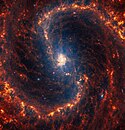Colours of the Lost Galaxy
The bright colours in this image aren’t just beautiful to look at, as they actually tell us about the population of stars within this barred spiral galaxy. The bright blue-ish colours, seen nestled amongst NGC 4535’s long, spiral arms, indicate the presence of a greater number of younger and hotter stars. In contrast, the yellower tones of this galaxy’s bulge suggest that this central area is home to stars which are older and cooler.
This galaxy was studied as part of the PHANGS survey, which aims to clarify many of the links between cold gas clouds, star formation, and the overall shape and other properties of galaxies. On 11 January 2021 the first release of the PHANGS-HST Collection was made publicly available.Relevante Bilder


Relevante Artikel
NGC 4535NGC 4535 ist eine Balken-Spiralgalaxie vom Hubble-Typ SAB(s)c im Sternbild Jungfrau auf der Ekliptik, die schätzungsweise 85 Millionen Lichtjahre von der Milchstraße entfernt. Die Entfernungsmessungen basierend auf den Radialgeschwindigkeiten stimmen nicht mit den rotverschiebungsunabhängigen Entfernungsschätzungen von 51 ± 12 Millionen Lichtjahren überein. Sie ist Teil des Virgo-Galaxienhaufens, einer Ansammlung von Galaxien, die alle durch ihre gegenseitige Anziehungskraft zusammengehalten werden. Weil die Galaxie in kleineren Teleskopen leicht zu übersehen ist, wird sie manchmal "Lost Galaxy" genannt. Dieser Spitzname geht auf einen Artikel des Amateurastronomen Leland S. Copeland aus den 1950er-Jahren zurück. .. weiterlesen
